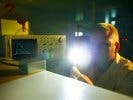The key to taking good pictures in these environments is to produce enough light energy from the flash while the picture is being taken. One measure of light energy is derived by summing the illuminance of the light source (measured in lux) over the duration of the flash exposure time. A light energy of 10-15 lux.sec is thought to be ideal for high-resolution pictures at low light levels.
Many camera phones already use LEDs to provide some flash functionality, but these have not proved equal to the task as they do not provide enough light energy to illuminate their subjects sufficiently. Most of today's phones with LED flash drive the LEDs at 1-2W and provide less than 4 lux.sec of light energy at a distance of 1m from the phone to the subject, and less than 1 lux.sec at 2m.
Higher power LEDs would seem like the next obvious development. However, to achieve full light intensity, these require up to 400% more current than the 800-1000mA that a phone battery can usually provide for LED flash.
+++++++
This article was published in the February 2007 issue of LEDs Magazine.
To read the rest of this article, please visit our Magazine page, where you can download FREE electronic PDF versions of all issues of LEDs Magazine.
You can also request a print copy of LEDs Magazine (available by paid subscription).






